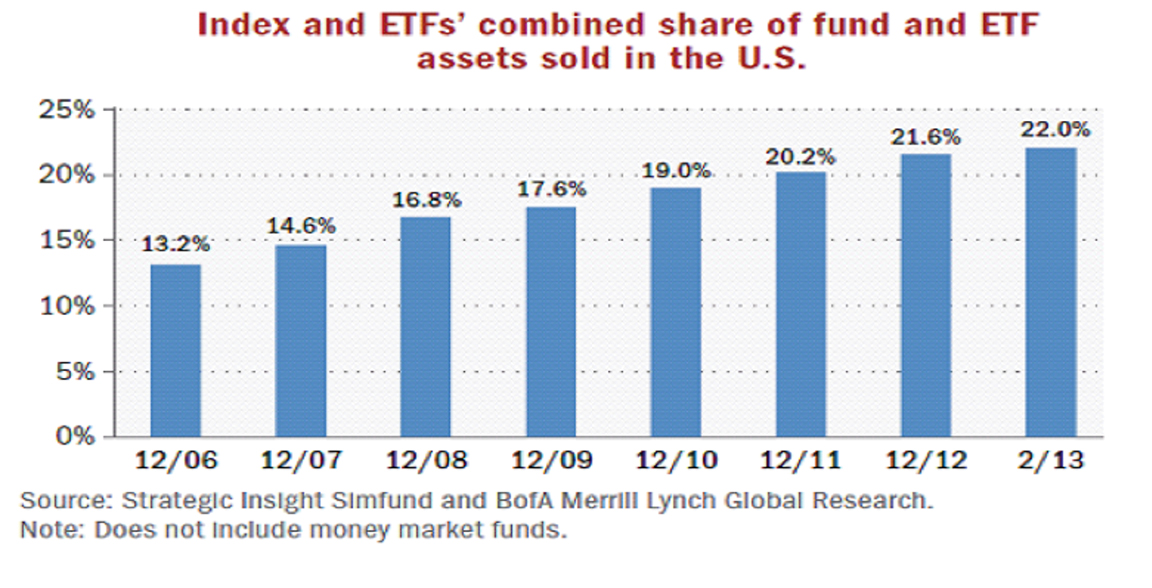Rise of the ETF

The growth in ETF (Exchange Traded Funds) use has been extraordinary. Currently, ETFs account for approximately 2 trillion in assets globally and 1.4 trillion in the US. [1] Most indexes have been replicated, and new indexes continue to be created for the purpose of creating new ETFs. The simple explanation why the ETF train has experienced rapid growth is because ETFs are relatively easy and inexpensive, active management can be difficult, and the growth of asset allocation models is driving growth.
Low fees coupled with a tax efficient structure (minimal capital gains distributions) are among the many reasons for the growth of the industry. Firms and managers like the purity of an ETF allowing them to allocate across sectors, industries, and capitalization size with ease and without a management bias that can creep into mutual funds and disturb an allocation model. [2]
The chart shows how assets in U.S. index products (index mutual funds and ETFs) have grown as a percentage of assets in all U.S. funds (mutual and index funds and ETFs). In the U.S., passive management has grown steadily to a 22% share in February 2013 from roughly a 12% share at the end of 2005.
ETFs gained recognition in the 1990s due especially to the powerful performance of the S&P 500 and the Nasdaq 100, known as the Q’s for its “QQQ” ticker symbol. The powerful rally in the technology stocks pushed them to the top of those indices, which helped drive those indices higher. As it became difficult for active managers to outperform those indices, the appeal of ETFs based on those indices grew rapidly.
There are hundreds of ETFs today, including actively managed ones. Know what the ETF owns and consider why you would want to use it either to capture the performance of an industry or for added diversification. Some ETFs use leverage which adds substantially to their risk. Others, especially leveraged short ETFs will only track to their index for a short period of time due to their structure. As a result, they may not perform as you would expect. Consult with your investment advisor to be sure the ETF you are considering will meet your objectives.
Past performance is not a guarantee of future results. It is not possible to invest in an index. Exchange Traded Funds are subject to risks similar to those of stocks. Investment returns may fluctuate and are subject to market volatility, so that an investor’s shares, when redeemed or sold, may be worth more or less than their original cost.
While expenses for ETFs are relatively low, investors incur commission costs when buying ETFs, just as they would if buying a stock. You should carefully consider the investment objectives, risks, charges and expenses of ETFs before investing. This and other important information is included in the prospectus, which should be read carefully before investing. Prospectuses can be obtained from your investment professional.
The Menashe Morley Group: David Menashe is a Senior Vice President and Wealth Management Advisor, Bruce Morley is a First Vice President and Wealth Management Advisor, and John Naviaux is a Financial Advisor for Merrill Lynch, Pierce, Fenner & Smith Incorporated, a registered broker-dealer, Member SIPC, and a wholly owned subsidiary of Bank of America Corporation. Investment products are not FDIC insured, are not bank guaranteed, may lose value. (858.381.8113)
[1] ETFGI, “End of Q3 2013 Report,” 14 October 2013.
[2] Maier, Jon. Merrill Lynch Wealth Management. “ETFs: Beyond the Basics,” 15 April 2013.






Comments